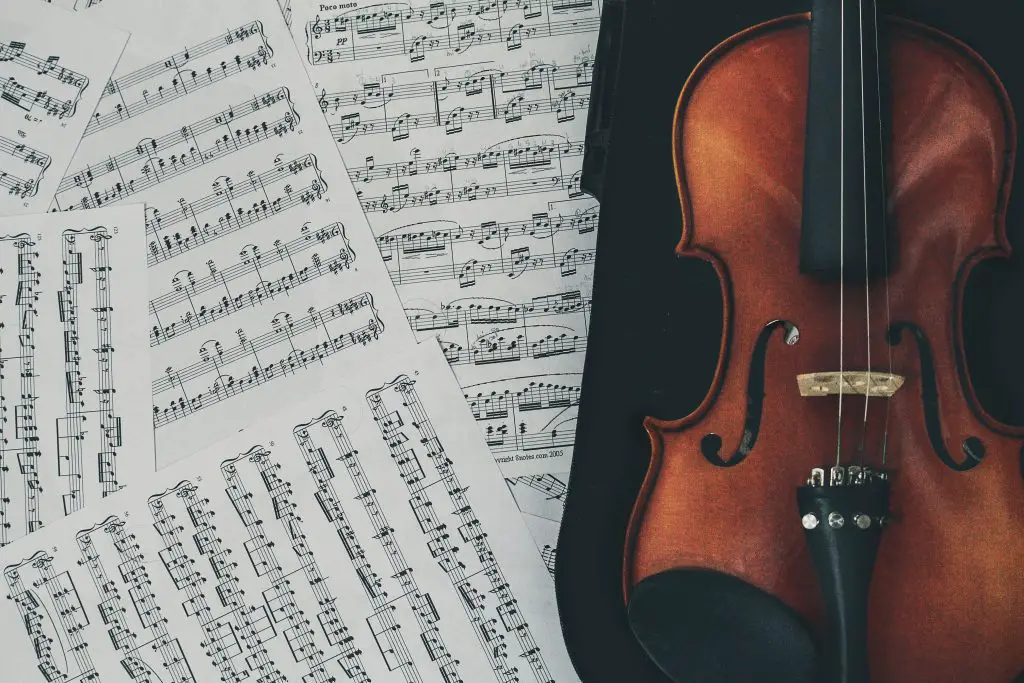Have you ever wondered what inversion is in music? Well, you’re in for a treat! In this blog post, we’re going to explore the fascinating world of inversion, where chords and melodies get flipped and transformed into new, exciting sounds. We’ll dive into the importance of inversion in music theory and composition and show you some examples from popular tunes. So buckle up because we’re about to turn your understanding of music upside down!
What is inversion in music? Inversion in music is the process of flipping chords or melodies to create new variations, making them sound fresh and unique.
What is the basic concept of inversion in music?
Inversion in music is all about rearranging the notes of chords or melodies to give them a fresh spin. This technique is a game changer in music theory and composition, as it helps to create variations, maintain interest, and improve the overall flow of a piece.

For instance, let’s talk about chord inversion. In a basic triad chord, you have three notes – the root, the third, and the fifth. With inversion, you can change the order of these notes, leading to different chord voicings.
So, if you have a C major chord (C-E-G), you can invert it by moving the C up an octave, resulting in E-G-C. This is called the first inversion. Do it again by moving the E up an octave, and you get G-C-E, which is the second inversion. Cool, right?
Inversion can also be applied to melodies. Melodic inversion is when you flip the intervals of a melody. For example, if you have a simple melody that goes C-D-E, you can invert it by mirroring the intervals so it becomes C-B♭-A♭. Inverting melodies allows you to create new musical ideas while maintaining the original essence of the melody.
AKAI Professional MPK Mini MK3

AKAI Professional MPK Mini MK3
How does inversion apply to chords and melodies?
Let’s dive deeper into how inversion works for both chords and melodies! We touched on this a bit earlier, but now it’s time to really explore how inversion can create new and interesting sounds in your music.
Chord inversion
Inverting chords is all about changing the order of the notes within the chord, which creates new voicings. This can add a fresh vibe to your compositions and help you transition smoothly between chords. Remember our C major example? We had the root position (C-E-G), first inversion (E-G-C), and second inversion (G-C-E).
Each inversion has a distinct sound, even though they all contain the same notes. Chord inversion is essential in understanding harmony and creating rich, complex textures in your music.
In this data table, we present a few popular chord inversions used in music, showcasing the root position, first inversion, and second inversion for each major chord. This will help you understand the different voicings that can be achieved by rearranging the notes within a chord, enhancing your compositions with smooth voice leading and harmonic interest.
| Chord | Root Position | First Inversion | Second Inversion |
|---|---|---|---|
| C | C-E-G | E-G-C | G-C-E |
| D | D-F♯-A | F♯-A-D | A-D-F♯ |
| E | E-G♯-B | G♯-B-E | B-E-G♯ |
| F | F-A-C | A-C-F | C-F-A |
| G | G-B-D | B-D-G | D-G-B |
| A | A-C♯-E | C♯-E-A | E-A-C♯ |
| B | B-D♯-F♯ | D♯-F♯-B | F♯-B-D♯ |
Melodic inversion
Now, let’s talk about inverting melodies. Melodic inversion is when you reverse the direction of the intervals in a melody. If a melody ascends by a certain interval, you would descend by the same interval in the inverted version. It’s like creating a musical reflection of the original melody.
For example, if you have a melody with the notes C-D-E-F (ascending by whole and half steps), the inverted melody would be C-B♭-A♭-G (descending by the same whole and half steps). By inverting the melody, you create a new musical idea while retaining the structure of the original melody.
Why is inversion important in music theory and composition?
Inversion plays a crucial role in music theory and composition, and there are several reasons why it’s so essential for musicians to understand and use this technique.
1. Smooth voice leading
First and foremost, inversion helps create smooth voice leading. This means that when you transition between chords, the individual notes move in the most efficient and least jarring way.
For example, if you’re moving from a C major chord (C-E-G) to an F major chord (F-A-C), you can use the first inversion of F major (A-C-F) to minimize the movement between the notes. This creates a smoother, more pleasing sound and makes your chord progressions flow naturally.
With inversion, you can explore new sonic landscapes, making your music more innovative and expressive.
2. Harmonic interest
Inversion also adds harmonic interest to your music. By using different inversions of chords, you create unique textures and variations in your compositions. This can help you avoid the monotony of using only root-position chords, which can make your music more engaging and dynamic. In short, inversion keeps things fresh and interesting!
3. Melodic variation
As we’ve discussed before, inversion can be applied to melodies as well. This technique allows you to create new melodic ideas while maintaining the original structure of a melody. By inverting a melody, you can generate countless variations, giving you endless possibilities for composing and arranging your music.
4. Enhanced creativity
Finally, understanding inversion allows musicians to think outside the box and experiment with their compositions. With inversion, you can explore new sonic landscapes, making your music more innovative and expressive. It’s a tool that can help you break the mold and push your creative boundaries!

Advantages and disadvantages of inversion in music
In this section, we’ll take a look at the pros and cons of using inversion in music, helping you understand the benefits and potential challenges of incorporating this technique into your compositions.
Advantages of inversion
Musical inversion has been a favored tool among composers and musicians throughout history. Here’s why:
- Fosters Creativity: Inversion provides an avenue for composers to expand their creative repertoire, helping to generate novel melodies from existing ones.
- Enhances Musical Complexity: It allows for increased musical complexity and richness, adding layers of depth to compositions.
- Promotes Thematic Continuity: It can aid in creating thematic continuity within a piece, providing cohesion and unity.
- Enables Variations: Inversion is an effective technique for producing variations on a theme, keeping the listener engaged while preserving familiarity.
- Expands Expressive Range: It expands the expressive range of a piece, offering new emotional and tonal possibilities.
Disadvantages of inversion
While musical inversion provides numerous advantages, it also comes with its own set of challenges:
- Requires Advanced Understanding: Inversion is a complex concept that requires a solid foundation in music theory to use effectively, potentially limiting its accessibility to beginners.
- Can Complicate Performances: It may increase the difficulty of a piece, making it more challenging to perform and potentially daunting for less experienced musicians.
- Might Lead to Predictability: Overuse of inversion can lead to predictability in a piece, making the music seem formulaic or uninspired.
- Risk of Losing Musical Identity: If not used carefully, it might cause a piece to lose its original thematic identity, causing confusion among listeners.
- Possibility of Listener Disconnection: Some listeners may find inversions challenging to understand or connect with, limiting their engagement or enjoyment of the music.
The advantages of inversion in music generally outweigh the disadvantages, but it’s essential to use this technique wisely and in moderation to maintain the desired balance in your compositions.
If you want even more tips and insights, watch this video called “What are Inversions? | Music Theory 3 | Video Lesson” from the Liberty Park Music YouTube channel.
Frequently asked questions (FAQ)
Do you still have questions about inversion is in music? Below are some of the most commonly asked questions.
What is the difference between chord inversion and melodic inversion?
Chord inversion refers to rearranging the notes within a chord to create new voicings, while melodic inversion involves reversing the direction of the intervals in a melody.
Do inversions only apply to major chords, or can they be used with minor chords as well?
Inversions can be applied to both major and minor chords, as well as other chord types like augmented, diminished, and extended chords. The concept of inversion remains the same: rearrange the notes within the chord to create new voicings and enhance your compositions.
Is inversion only used in classical music, or can it be applied to other genres?
Inversion is a versatile technique that can be applied to various musical genres, from classical to jazz, pop, rock, and beyond.
By using inversion in your music, you can create smoother transitions, add harmonic interest, and generate new melodic ideas, making your compositions more engaging and dynamic, regardless of the genre.
Conclusion
Well, folks, we’ve reached the finale of our exploration of inversion in music. I hope this post has been instrumental in helping you grasp the ins and outs of this essential technique. So, did this article strike a chord with you?
And did I cover everything you wanted to know? Let me know in the comments section below (I read and reply to every comment). If you found this article helpful, share it with a friend, and check out my full blog for more tips and tricks on music production and theory. Thanks for reading, and keep hitting those high notes in your compositions!
Key takeaways
This article covered inversion in music. Here are some key takeaways:
- Inversion is the process of rearranging notes in chords or melodies.
- Chord inversion creates new voicings and smooth voice leading, while melodic inversion generates new musical ideas.
- Inversions can be applied to major, minor, and other chord types.
- Inversions are used in various musical genres to enhance compositions.
- Using inversions has both advantages and disadvantages, but generally, the benefits outweigh the drawbacks.















